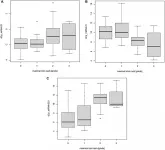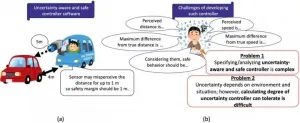(Press-News.org) Opioid prescribing preferences and practices among surgical residents and faculty differ, according to a new study published in the journal Surgery.
The study, titled "Evaluation of opioid prescribing preferences among surgical residents and faculty," was based on a survey of 56 residents and 57 faculty within the University of Colorado School of Medicine Department of Surgery. In the survey, participants were asked how many oxycodone tablets they would prescribe for 14 common surgical procedures.
Answers were compared between residents and faculty, as well as against the Opioid Prescribing Engagement Network (OPEN) guidelines and actual opioids prescribed (pulled from electronic medical records).
"The opioid epidemic is a huge problem," says Sarah Tevis, MD an assistant professor of surgery in Breast Surgical Oncology and the study's principal investigator. "We know that more than two thirds of the prescriptions that surgeons prescribe aren't used in the immediate post-operative period by patients and that one in 16 patients who are prescribed opioids for surgery end up having chronic opioid use."
"It's been very well established that post-operative opioid prescribing varies across the board," continues Victoria Huynh, MD, a third-year resident in the department and first author on the study. "We wanted to look at how we're doing as a department in terms of opioid prescribing."
Comparing resident and faculty opioid prescribing habits
The results showed that faculty preferred to prescribe more opioid tablets than suggested by OPEN in five of the 14 surgical procedures, while residents did so in nine of the procedures.
"In some instances, faculty and residents prescribed more than suggested for certain surgical procedures. So that's certainly an opportunity for improvement," Huynh says. "But I think the most striking aspect of the study was just how much faculty and resident prescribing preferences differ from each other."
Tevis said one of the reasons providers may prescribe more than suggested by the OPEN guidelines is CU's large catchment area.
"We have patients coming from hours away and from other states for surgery. So, one factor may be that prescribers are worried that patients are going to drive eight hours home and then not have enough pain medicine," Tevis says.
Another concern is patient satisfaction. Tevis says providers may be worried that a patient who runs out of pain medicine will be less satisfied with their care or need to call back or even go to the emergency room for more pain medication.
As for why residents seem to prefer prescribing more opioids than faculty, Huynh thinks it may be at least partially due to the limited interaction residents have with patients after surgery.
"We often see patients pre-op and immediately post-op, and we help take care of them in the immediate post-operative period while they're in the hospital," Huynh says. "But as far as the post-operative follow-up care, we're not as involved as the attendings are."
Tevis agrees. "When I call patients with their pathology results about a week after surgery, I also ask them about their pain control. But the residents miss out on a lot of that feedback."
The study also assessed the frequency with which faculty communicate prescribing preferences to residents and the desire among all participants for feedback and transparency in prescription practices.
Both residents (80%) and faculty (75%) were open to seeing regular reports of personal opioid prescription practices, and most of those were also open to seeing how their numbers compared with their peers.
Education and assessment: initiatives to address post-operative opioid over-prescription
Since studies show that most prescription opioid abusers get medication from family and friends, the challenge is learning how to adequately treat post-operative pain while limiting opportunities for misuse and diversion.
"For us, that means limiting the excessive opioids that we prescribe," Huynh says.
As a result of their research, Huynh and some of her co-residents are setting up ongoing initiatives within the Department of Surgery to address over-prescription of opioids. For instance, they have been developing a dashboard that will allow anyone who prescribes opioids to receive regular feedback about how much they're prescribing and how their prescribing practices compare with their peers. They recently sent it out to a handful of faculty to get feedback on the functionality and features.
"We're hoping that once we get that worked out, we can send it out to the entire department so that everybody can use it," Huynh says.
Tevis, one of the faculty members who has started using the dashboard, says it is already proving effective. "Surgeons are competitive people," she says. "So, when we get that email every month, my partners and I immediately start emailing back and forth about how we did compared to last month, how we're all doing compared to each other. I think people are really liking that feedback, and it's influencing what they're doing."
In addition to the dashboard, Huynh and her colleagues have built pathways (called Enhanced Recovery after Surgery protocols) that providers can follow through a patient's electronic medical record. The pathways recommend which pain medications to order before and after surgery, including how many opioids to prescribe for certain procedure based on the national guidelines.
Tevis predicts the pathways will be especially helpful for residents who periodically rotate between different services.
"If you haven't been on the breast service for three years, how are you going to remember how many pills you should prescribe after a lumpectomy?" she asks. "If it's built into this pathway, it becomes very clear."
The clinicians have also developed a protocol to utilize multimodal pain management to try to decrease the need for opioids after surgery, as well as instituted an educational program for interns around opioid prescribing.
"It's really impressive what Tori has accomplished in just two years in the research lab," Tevis says. She's examined this problem from multiple angles, and her work has already led to big changes in the Surgery Department."
INFORMATION:
A new screening method that can test the effectiveness of therapeutic molecules designed to 'glue' proteins together in the body has been developed by researchers at the University of Birmingham and the University of Leicester.
The research paves the way for drug developers to screen large numbers of potential new drug compounds to discover new treatments for diseases such as breast cancer and Parkinson's disease.
The ways in which proteins interact with each other are fundamental to all cell functions. These interactions underpin every function of a healthy body, with any slight change in these interactions resulting in disease.
A handful ...
Scientists at the University of Cambridge have identified rare genetic variants - carried by one in 3,000 people - that have a larger impact on the risk of developing type 2 diabetes than any previously identified genetic effect.
Type 2 diabetes is thought to be driven in part by inherited genetic factors, but many of these genes are yet unknown. Previous large-scale studies have depended on efficient 'array genotyping' methods to measure genetic variations across the whole genome. This approach typically does a good job at capturing the common genetic differences between people, though individually these each confer only small increases in diabetes ...
DALLAS, July 7, 2021 -- Myocarditis in children is a rare yet challenging condition to treat. Diagnosis and treatment includes multiple options, and many cases of myocarditis resolve on their own, according to a new scientific statement from the American Heart Association, "Diagnosis and Management of Myocarditis in Children," published today in Circulation, the Association's flagship journal. The scientific statement writing group reviewed the latest research to develop guidance in diagnosis and treatment for myocarditis in children.
Myocarditis is inflammation of the middle layer of the wall of the heart muscle, the myocardium, and it ...
The newly developed method lets researchers rapidly and accurately measure stress hormones in snow leopards without the need for bulky equipment or specialised knowledge. It uses widely available equipment that can be carried into the field, allowing hormone extraction from faecal samples and analysis to be done on site.
This differs from existing approaches to hormone monitoring in wild animals, where faecal samples must be taken to laboratories for hormone extraction and analysis. These approaches are particularly limiting in remote locations, such as the Himalayas.
"Because conventional hormone monitoring methods require frozen and refrigerated chemical reagents, and laboratory equipment, it is almost impossible to use them on-site." explained ...
CLEVELAND, Ohio (July 7, 2021)--Estrogen has been thought to play a role in a woman's risk of developing Alzheimer disease (AD). A new study has taken a different approach to identifying risk factors for AD by examining the association between a woman's reproductive life span as an indicator of endogenous estrogen exposure and levels of cerebrospinal fluid biomarkers. Study results are published online in Menopause, the journal of The North American Menopause Society (NAMS).
Alzheimer disease represents 60% to 70% of all dementia diagnoses, making it the most common form of dementia. Approximately ...
A new study in the Journal of the European Economic Association, published by Oxford University Press, finds that electoral districts with a larger gender pay gaps show favoritism toward male political candidates in Parliamentary elections, with fewer female candidates on the ballot.
The researchers here gathered data for seven parliamentary elections in France between 1988 and 2017. Researchers studied candidates from the Left and Right political coalitions, which account for 80% of elected members of Parliament. The researchers consulted administrative and web data on candidates and electoral outcomes, survey data on ...
Oncotarget published "Association between miRNA signatures in serum samples from epidermal growth factor inhibitor treated patients and skin toxicity" which reported that on average 70% of patients treated with EGFRIs suffer from skin toxicity.
Studies showed a correlation between overall survival and the appearance of a skin rash, which is used as a biomarker for therapy efficacy.
In this study, the authors searched for associations of miRNA expression profiles in serum, with the severity of skin rash, in order to identify tentative therapy predictive biomarkers.
In this cohort of patients treated with EGFR inhibiting monoclonal antibodies, miR-21 and miR-520e serum concentrations were negatively correlated with severity of skin rash whereas for miR-31, a positive correlation was ...
A research team consisting of Tsutomu Kobayashi, Ichiro Hasuo, Fuyuki Ishikawa, and Shinya Katsumata at the National Institute of Informatics (NII, Japan) and Rick Salay and Krzysztof Czarnecki at University of Waterloo (Canada) developed a method that automatically transforms models of controller software into models that satisfy safety requirements even when there is uncertainty in sensing the state of the environment. In addition to the transformation, the method generates formulas that represent the degree of uncertainty that the controller software can tolerate. The method can be applied to various controller systems that interact with the external environment, ...
In the line-up of wild African fruits, the marula is the best known. For thousands of years, people have depended on the trees for food, medicines, and more. It is also exported globally as the rockstar ingredient of a cream liqueur. The fruit is a success story far beyond the savannas and bushveld where the trees grow.
But there is a whole choir of other wild, indigenous fruits in Southern Africa. And some exceed daily nutritional values recommended by the WHO and others.
Research from the University of Johannesburg uncovers a variety of building blocks for protein in the fruit of 14 species. Several are analyzed for ...
Coastal communities across the world are increasingly facing up to the huge threats posed by a combination of extreme storms and predicted rises in sea levels as a result of global climate change.
However, scientists at the University of Plymouth have developed a simple algorithm-based model which accurately predicts how coastlines could be affected and - as a result - enables communities to identify the actions they might need to take in order to adapt.
The Forecasting Coastal Evolution (ForCE) model has the potential to be a game-changing advance in coastal evolution science, allowing adaptations in the shoreline to be predicted over timescales of anything from days to decades and beyond.
This broad range of timescales means that the model is capable of predicting ...


